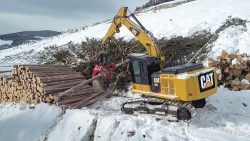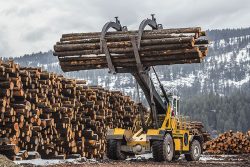
Features
A sustainable future for forestry
August 30, 2022 By Brian Mulvihill
 Many forestry companies and equipment dealers have committed to reducing their environmental impact.
Many forestry companies and equipment dealers have committed to reducing their environmental impact.
Forestry operations face daily challenges – from difficult terrain, remote locations, weather and labour shortages to low timber prices, tariffs, mill closures and government uncertainty. Now there are new pressures from boards, investors and stakeholders to improve energy efficiency and reduce greenhouse gas (GHG) emissions.
Evolving into a more sustainable logging operation is a big commitment and comes with many logistical and change management hurdles. To meet these challenges, the forestry industry of the future needs to be one that considers its impact on the environment at all stages of the logging process.
The introduction of EPA Tier 4 emissions standards for equipment in 2014 was the first starting point. Tier 4 engines use Diesel Exhaust Fluid (DEF), sophisticated sensors and controls, with the addition of filters to help reduce emissions of smog-forming pollutants, like nitrous oxides and particulate matter. While it is a good starting point, there’s more room for improvement when it comes to GHGs. For loggers, this presents an opportunity for innovative thinking – keeping up productivity while reducing GHG emissions.
The time for emissions reduction is now

Loggers challenge: keeping up productivity while reducing GHG emissions. Photos courtesy of Finning.
Through Environment Social Governance (ESG) reporting, many forestry companies and equipment dealers have committed to reducing their near-term environmental impact, while also making bolder long-term pledges. Corporate sustainability reports outlining actions like equipment rebuilds, waste reduction, sustainable forestry management, renewable power, and even electrification – ESG is now built into corporate strategies. Forests are seen as a vital part of the climate solution – by sucking up carbon, they reduce the amount of CO2 in the atmosphere and in turn decrease the impacts of climate change. But to realize the benefits of a sustainable circular economy, the forestry industry as a whole must be on board. Each part of the supply chain needs to work together to offer innovative solutions to drive real change.
A carbon footprint assessment can identify, quantify and track emissions that contribute towards a company’s carbon footprint. The first step is to identify areas for improvement during the production cycle, which are referred to as scopes. Scope 1 – Direct – includes direct emissions from controlled sources such as emissions related to operations or purchased energy consumed in operations. Scope 2 – Indirect – is categorized by indirect emissions, such as an improved electrical grid. Expanding beyond the mandatory reporting of scope 1 and scope 2 GHG emissions has the potential to play a key role in emission reduction efforts.
Scope 3 – Indirect Downstream – is often the hardest to monitor as it involves the whole supply chain, including indirect emissions that occur from both upstream and downstream activities. Since the use of carbon-based fossil fuels is the most significant contributing factor to GHG emissions, reductions during scope 3 are not only possible, but can have significant impact on ESG reporting. As a carbon-intensive practice during the extraction and transportation process, forestry is under increased pressure from government regulations and investors to report on scope 3. The Canadian government’s recently issued climate plan involves new carbon pricing and regulations that require further reductions in GHG emissions. Federally, two components are applicable – a fuel charge on fossil fuel consumption and a performance-based system.
Finding ways to reduce fuel burn should be THE key priority for every contractor. It not only helps lower emissions but can reduce costs too. Where to start is often the most daunting task. The first step involves tracking and understanding how much carbon you are emitting. Once you have this information you can develop a plan to reduce it.
Reducing GHG emissions through digital optimization
 Working with a dealer who has access to the right tools can not only help you track emissions but can also help stretch the life of equipment and provide substantial cost savings in the long run. Dealers can support data collection and analysis as well as operational insights such as fuel consumption, site safety, tracking maintenance and service requirements to maximize uptime.
Working with a dealer who has access to the right tools can not only help you track emissions but can also help stretch the life of equipment and provide substantial cost savings in the long run. Dealers can support data collection and analysis as well as operational insights such as fuel consumption, site safety, tracking maintenance and service requirements to maximize uptime.
Many equipment and technology dealers now offer customer value agreements (CVAs) which help to analyze real time machine data for better decision making and increased productivity. Be sure any software platform you use allows you to access your dealership services digitally. Your dealer should also provide capabilities and insights to drive efficiency in your day-to-day operations, supporting you in meeting sustainability goals and optimizing equipment productivity.
Enabling GHG emissions reductions through digital optimization can provide a direct line of sight to your carbon emissions. Equipment connectivity and data analytics can also supply you with the insights needed to decrease idle time and lower fuel consumption rates, while increasing asset utilization. Consistent tracking and reporting allow access to key performance metrics across the entire fleet, reducing GHG emissions by production unit. You can calculate your fuel consumption rate based on productive working hours vs. non-productive idling hours. By viewing the daily fuel burn performance of each machine, you can access information to help isolate which machines are consuming fuel at a higher rate and find out why. Your dealer can make necessary recommendations such as more training for inexperienced equipment operators or scheduling an underperforming machine for service or parts replacement.
Establishing a baseline for your environmental and sustainability goals is key to future success. Identifying and implementing those solutions can help reduce emissions and lower fuel use. Your dealer can help support you in this journey – measuring and monitoring CO2 emissions data and recommending actionable insights for improving operational efficiency. Better visibility into fuel burn, carbon emissions, and equipment utilization, also means maximizing the efficiency of your fleet and reducing operational costs.
A shift in perspective
In an industry which has a certain way of doing things, change can be hard. The daily demands and challenges of logging still exist. Real change happens when we embrace the technology and digital solutions that can help enhance safety, data management and reporting. Emissions concerns in forestry have taken a back seat over the last decade. However, with new carbon pricing, regulations, and investors demanding GHG emission reductions, it’s an issue which can no longer be ignored.
As the forestry industry attempts to battle environmental misinformation and mistruths, providing viable solutions, including access to information and data, gives companies the tools to make more environmentally responsible decisions. However, avoidance behaviour do nothing but undermine those advancements and solutions. Continuously evolving technologies and more environ-mentally friendly equipment, including electrification in the future, provide an opportunity for logging contractors to step forward and lead the change.
Brian Mulvihill is the industry manager for forest products at Finning Canada.
Print this page